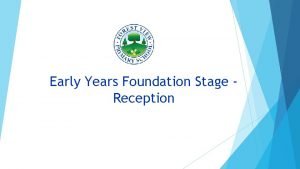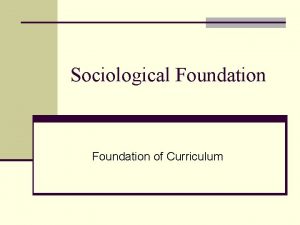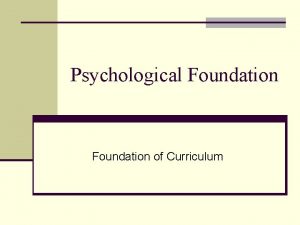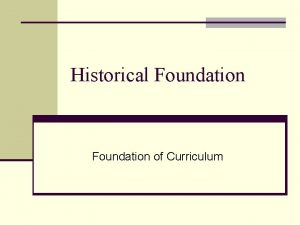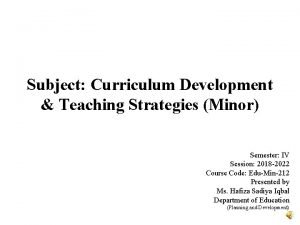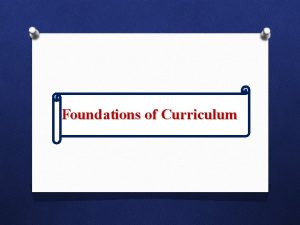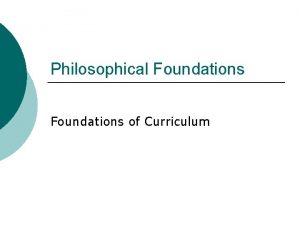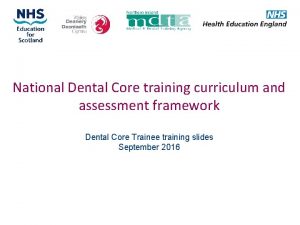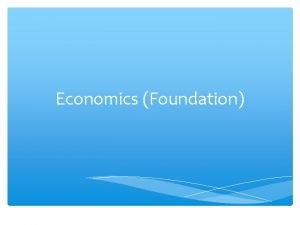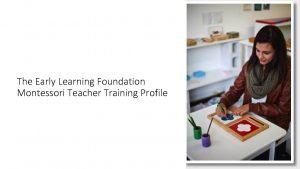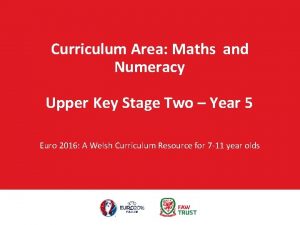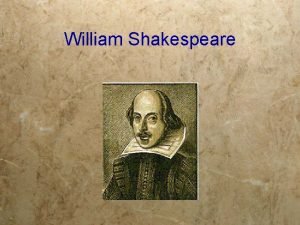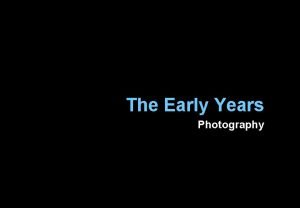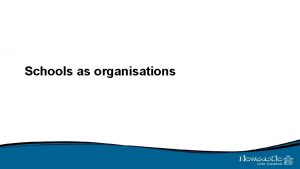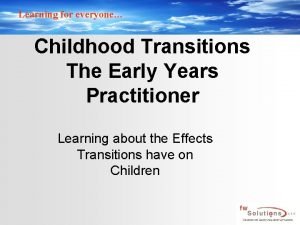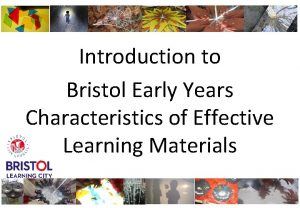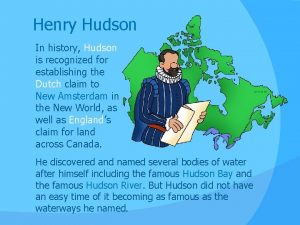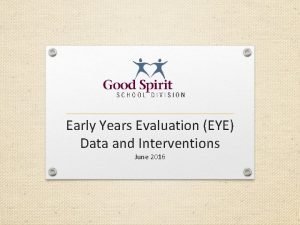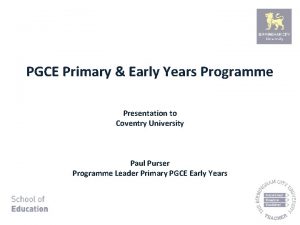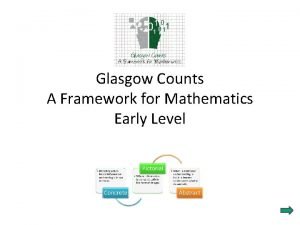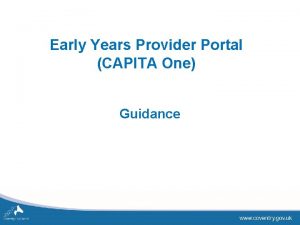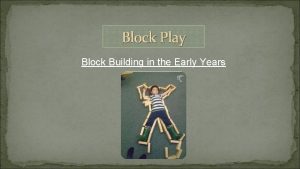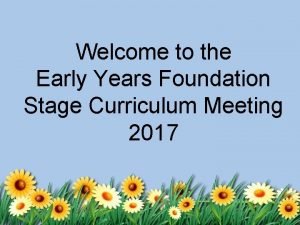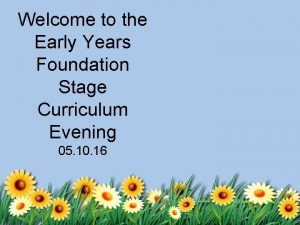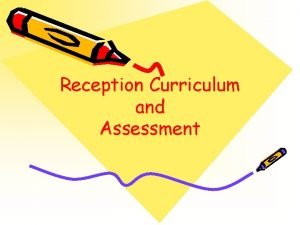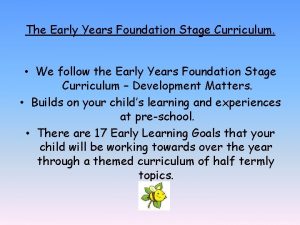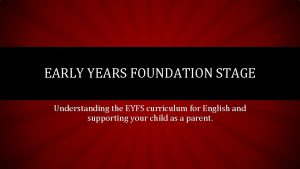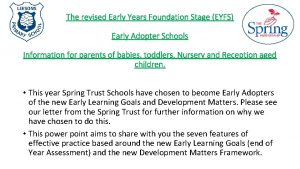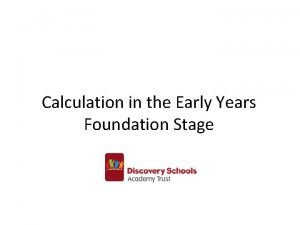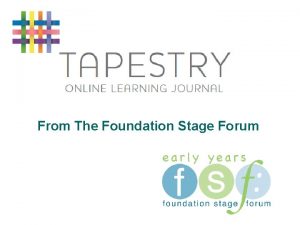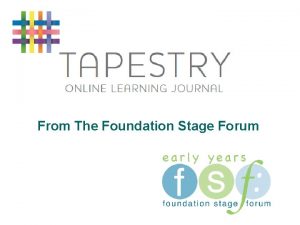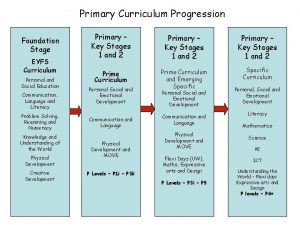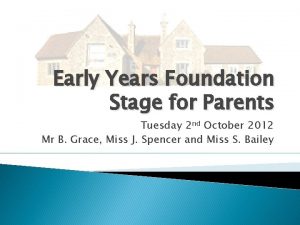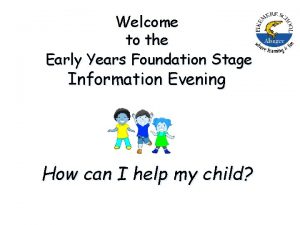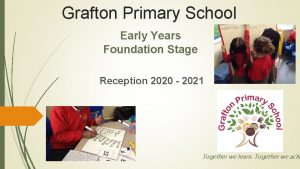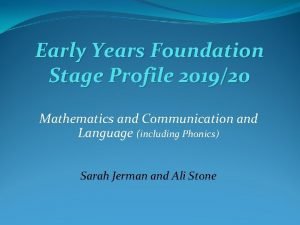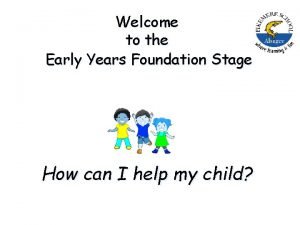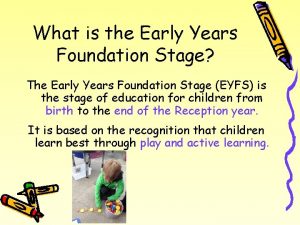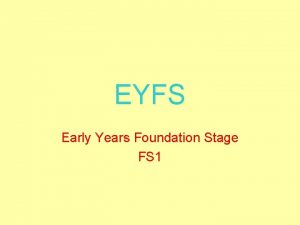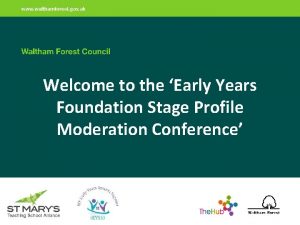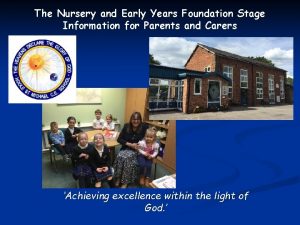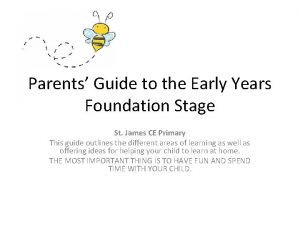The Early Years Curriculum Early Years Foundation Stage


































- Slides: 34

The Early Years Curriculum

Early Years Foundation Stage

The 7 areas of learning and development • Communication and Language • Personal, social and emotional • Physical development • Literacy • Mathematics

Listening, attention and Understanding • Listen in a small group and one to one • Listen to a story with increasing attention and recall • Join in with repeated refrain • Anticipate key events in rhymes and stories • Focus attention • Follow instructions • Maintain attention • Two channelled attention- listen and do

Listening, attention and Understanding • Understand the uses of objects • Understand prepositions under, on behind by carrying out action or identifying in pictures • Respond to simple instructions • Beginning to understand why and how questions

Listening, attention and Understanding • Respond to two part instructions • Understand humour • Follow a story without pictures or props • Listen to others’ ideas

Speaking • Begin to use more complex sentences (and, because) • Retell simple past events • Use talk to connect ideas • Question why things happen • Who, what, when, how • Build up vocabulary • Relate vocabulary to things of importance

Speaking • Extend vocabulary to include new words and meanings • Use language in role-play • Link statements and stick to a main theme • Use talk to clarify thinking, ideas, feelings and events • Introduce a storyline or narrative in their play

Literacy - Reading Rhymes Alliteration Rhythm Listening Enjoy books Begin to understand use of print

Reading • • • Rhyming string Hear and say initial letter sounds Segment and blend words Link sounds to letters Read simple words and sentences

Phonics is. . . • Knowledge of the alphabetic code • Skills of segmenting and blending

Important words • Phoneme - smallest unit of sound in a word • Grapheme - a letter or sequence of letters that represents a phoneme.

Pronouncing phonemes 1. f l m n r s sh v th z (continuous phonemes) 2. e p t ch h (unvoiced) 3. b d g w qu y j (voiced)

Key Principles – What we teach your children • Sounds/phonemes are represented by letters • A phoneme can be represented by one or more letters e. g. sh, ch, th, ee, ai. . . • The same phoneme can be represented/ spelled in more than one way e. g. rain, may, lake • The same spelling may represent more than one sound e. g. mean, deaf

How we teach your children • Phonics begins in Nursery with Phase 1 • Phase 2 starts in Reception where sounds are introduced in sets

Phase 1 • Aspect 1 - General sound discrimination – environmental • Aspect 2 - General sound discrimination - instrumental sounds • Aspect 3 - General sound discrimination - body percussion • Aspect 4 - Rhythm and rhyme • Aspect 5 – Alliteration • Aspect 6 - Voice sounds • Aspect 7 - Oral blending and segmenting

Phase 2 Set 1: s, a, t, p Set 2: i, n, m, d Set 3: g, o, c, k Set 4: ck, e, u, r Set 5: h, b, f, ff, l, ll, ss

Phase 3 Set 6: j, v, w, x Set 7: y, z, zz, qu Consonant digraphs: ch, sh, th, ng Vowel digraphs: ai, ee, igh, oa, oo, ar, or, ur, ow, oi, ear, air, ure, er

Phase 4 Children will : • know a grapheme for each of the 42 phonemes. • be able to blend phonemes to read CVC (consonant -vowel-consonant) words and segment in order to spell them. • have begun reading straightforward two-syllable words and simple captions, as well as reading and spelling some tricky words.

Common Exception Words

Daily Phonics Sessions • Revisit/review – revise previously taught phonemes • Teach – new learning • Practise – reading/writing words • Apply – reading/writing captions

Resources and strategies • • Phoneme fingers Sound buttons Phoneme frames Whiteboards Songs and rhymes Puppets and props Power. Point presentations Web based games

Supporting Early Writing

Children’s writing is based on skills and understandings which they develop as babies and toddlers. Before they can write, they need to learn to use spoken language to communicate. Later they learn to write down the words they can say. (Development Matters 2012)

Early Mark making Enjoys the sensory experience of making marks in damp sand, paste or paint.

Hold pen or crayon using a whole hand grasp and makes random marks with different strokes.

Begin to distinguish between marks they make Sometimes gives meaning to marks as they draw and paint. Ascribes meanings to marks that they see in different places.

How we support this stage in school • Mark making on a large scale indoors and outdoors • Mark making resources in all areas of the provision • Painting • Malleable materials • Activities using manipulative skills to develop fine motor skills

Use some clearly identifiable letters to communicate meaning, representing some sounds correctly and in sequence. Writes own name and other things such as labels, captions. Attempts to write short sentences in meaningful contexts.

Developing pencil grip

How we support this stage in school • Writing opportunities in all areas of the provision indoors and outdoors • Daily phonics session • Formal writing task ‘busy job’ every day • Writing for a purpose in a meaningful context

Mathematics - Number • Fast recognition of up to 3 objects, without having to count them individually (subitising). • Recite numbers past 5. • Say one number for each item in order: 1, 2, 3, 4, 5. • Know that the last number reached when counting a small set of objects tell you how many there are in total (cardinal principle). • Show finger numbers up to 5. • Link numerals and amounts. • Experiment with their own symbols and marks as aswell as numerals. • Solve real world mathematical problems with numbers up to 5.

Mathematics – Numerical Pattern • Compare quantities using language ‘more than’, ‘fewer than’. • Talk about and explore 2 D and 3 D shapes using informal and mathematical language. • Understand position through words alone. • Describe a familiar route. • Discuss routes and locations. • Make comparisons between objects relating to size, length, weight, capacity. • Select shapes appropriately. • Combine shapes to make new ones. • Talk about and identify the patterns around them. • Extend and create ABAB patterns. • Notice and correct an error in a repeating pattern. • Begin to describe a sequence of events, real or fictional.

How we support Mathematics in school Provide opportunities in the areas using everyday objects for the children to use and count • Use of numicon and Numberblocks in the indoor and outdoor environment • Using snack time as an opportunity to discover maths further • The use of indoor and outdoor environment. •
 Early years foundation stage pack
Early years foundation stage pack Pad foundation section
Pad foundation section Composition of urine
Composition of urine Social foundation of curriculum
Social foundation of curriculum Behaviorism curriculum
Behaviorism curriculum Historical foundation of curriculum
Historical foundation of curriculum Pragmatism and curriculum
Pragmatism and curriculum Philosophical foundation of curriculum
Philosophical foundation of curriculum Sociological bases of curriculum
Sociological bases of curriculum Philosophical foundatioins of curriculum
Philosophical foundatioins of curriculum Dental core training
Dental core training Economic foundation of curriculum
Economic foundation of curriculum Foundation stage 2
Foundation stage 2 Sheep years to human years
Sheep years to human years 300 solar years to lunar years
300 solar years to lunar years Four scores and seven years ago
Four scores and seven years ago Mtt teacher training
Mtt teacher training Upper key stage 2 maths
Upper key stage 2 maths Who was shakespeare
Who was shakespeare First photograph of a person
First photograph of a person Summarise types of early years provision
Summarise types of early years provision Medway early years
Medway early years Effects of transitions in early years
Effects of transitions in early years Bristol characteristics of effective learning
Bristol characteristics of effective learning Early life of henry hudson
Early life of henry hudson Sfyc hampshire
Sfyc hampshire Early years learning framework overview
Early years learning framework overview Eye early years evaluation
Eye early years evaluation Developmental milestones 20-40 years
Developmental milestones 20-40 years Pgce early years
Pgce early years Glasgow counts framework
Glasgow counts framework Coventry early years portal
Coventry early years portal Block play early years
Block play early years Picasso early years
Picasso early years Mark making early years
Mark making early years
